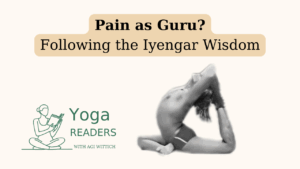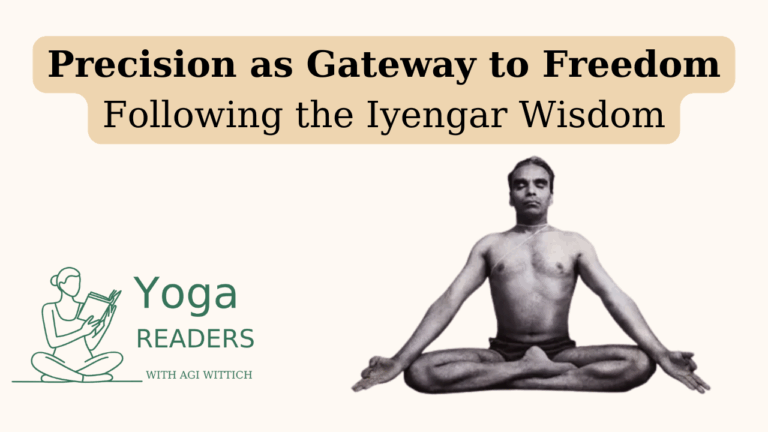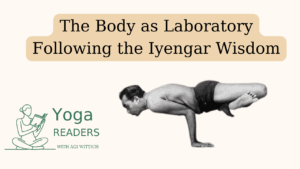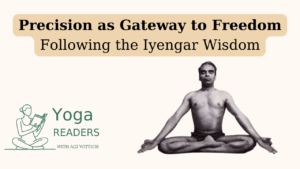
Pain as Guru: Embracing Challenge as the Path to Wisdom
“Pain is your guru.” — B.K.S. Iyengar, Light on Life This bold teaching from B.K.S. Iyengar often provokes discomfort—not just because it involves pain,

“Asana is perfect firmness of body, steadiness of intelligence, and benevolence of spirit.”
—B.K.S. Iyengar
This definition invites us to rethink what it means to be precise in practice. In the Iyengar method, precision is not the pursuit of external symmetry for its own sake. It is a discipline of attention, a tool to refine perception, and ultimately, a gateway to svatantrya (freedom).
Precision, in our tradition, is the art of making conscious, intelligent contact with the various kosas, first through the body, then gradually through breath, mind, and intelligence. When attention penetrates evenly across the body, when each limb participates with integrity and purpose, we experience the asana not as an imposed shape, but as an embodied revelation.
Intelligence in Action
As Guruji reminds us in Light on Life:
“Rigidity comes from impurity, from accumulated toxins, whether in the physical sense or the mental, when we call it prejudice or narrow-mindedness.”
Precision is our antidote. It clarifies and purifies. It is the work of viveka, which is the discriminative intelligence that enables us to discern between effort and violence, between action and agitation, between opening and overstretching.
This clarity is not theoretical, it is profoundly practical. Geeta S. Iyengar, in Yoga: A Gem for Women, offers exquisite examples of how precision, especially when aided by props, it is but liberating.
“Easy stages are for those who cannot do an asana independently and who need the support of a table, a wall, or a piece of furniture.”
Props serve alignment not as crutches, but as instruments of education. With them, the structure of the pose becomes accessible, and through that structure, the deeper work can begin. In this view, adaptation clarity.
The Embodied Eye: Cultivating Internal Perception
Guruji’s instruction that “each pore of the skin must become an eye” reminds us that this work is not about external display but internal precision. We are training buddhi, the intellect, to perceive subtle imbalances and to respond with intelligent adjustment.
As he often said, “Action is movement with intelligence.” Mechanical repetition has no place here. Our task is not to move, but to act. With precision, every movement becomes an intentional expression of citta vrtti nirodhah, the quieting of the fluctuations of consciousness.
Freedom Through Structure
It is one of the paradoxes of this method: the more skillfully we work within defined parameters, the more we experience expansion, lightness, and liberation. Like a dancer who moves freely because they’ve mastered the form, or a raga that soars within the constraints of a melodic framework, the yoga practitioner finds freedom because of structure.
As Guruji writes in The Tree of Yoga:
“Freedom implies not being battered by the dualities of life, its ups and downs, its pleasures and its suffering.”
We do not reach this freedom by avoiding boundaries, but by working consciously within them. In this way, tapas (disciplined effort), svādhyāya (self-study), and Īśvarapraṇidhāna (surrender) converge.
Before diving into these questions, why not support this kind of in-depth yoga writing and teaching? Buy me a chai ☕ and help sustain this work.
Practice Today: The Discipline of Perception
Choose one foundational āsana, and approach it not as something you “already know,” but as a fresh opportunity to observe. Use the mirror of the body to detect asymmetries in action.
Use a block, a wall, or a belt, to deepen your perception. Let the pose become a study in internal architecture.
Observe: what effect does this conscious precision have on your citta? On the breath? On your internal state? Can you touch, even briefly, anandamaya kosa, the innermost sheath of bliss?
This is the essence of the Iyengar method: to use discipline as a doorway, precision as a path, and structure as a means to freedom.

“Pain is your guru.” — B.K.S. Iyengar, Light on Life This bold teaching from B.K.S. Iyengar often provokes discomfort—not just because it involves pain,

“To a yogi, the body is a laboratory for life, a field of experimentation and perpetual research.”—B.K.S. Iyengar This insight from Guruji is not

“Asana is perfect firmness of body, steadiness of intelligence, and benevolence of spirit.”—B.K.S. Iyengar This definition invites us to rethink what it means to
Agi Wittich is a yoga practitioner since two decades, and is a certified Iyengar Yoga teacher. Wittich studied Sanskrit and Tamil at the Hebrew University of Jerusalem, Israel, completing a PhD with a focus on Hinduism, Yoga, and Gender. She has published academic papers exploring topics such as Iyengar yoga and women, the effects of Western media on the image of yoga, and an analysis of the Thirumanthiram yoga text.